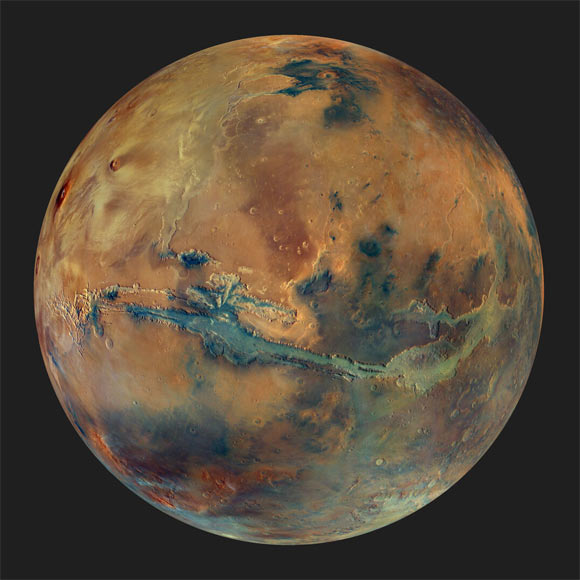Geoscientists from Australia and France have used the geological record of Earth’s deep oceans to discover a connection between the orbits of our home planet and Mars. They’ve discovered a surprising 2.4-million-year cycle where deep currents wax and wane which, in turn, is linked to periods of increased solar energy and a warmer climate.
This image from Mars Express’ High Resolution Stereo Camera shows the globe of Mars set against a dark background. The disk of the planet features yellow, orange, blue and green patches, all with an overall muted grey hue, representing the varying composition of the surface. Image credit: ESA / DLR / FU Berlin / G. Michael / CC BY-SA 3.0 IGO.
“In 1976, scientists demonstrated for the first time the presence of 10,000 – 100,000-year astronomical cycles in Pleistocene deep-sea sediments, confirming Milutin Milankovitch’s theory that Earth’s climate is modulated by periodicities in perturbations of Earth’s orbit around the Sun and Earth’s spin axis,” said University of Sydney researcher Adriana Dutkiewicz and her colleagues.
“Apart from the well-known astronomical cycles with periods of 19,000, 23,000, 41,000, 100,000, and 400,000 years that pace Earth’s climate, the geological record also contains signals of much longer-period grand cycles, which are predicted by astronomical theory.”
“These grand cycles include orbitally-forced periodicities of millions and even tens of millions of years that are similarly linked to changes in incoming solar energy and paleoclimate.”
In their new research, the authors used the deep-sea sediment record to check for links between sedimentary shifts and changes in the Earth’s orbit.
They found that the vigor of deep-sea currents shifts in 2.4-million-year cycles.
“We were surprised to find these 2.4-million-year cycles in our deep-sea sedimentary data,” Dr. Dutkiewicz said.
“There is only one way to explain them: they are linked to cycles in the interactions of Mars and Earth orbiting the Sun.”
“The gravity fields of the planets in the solar system interfere with each other and this interaction, called a resonance, changes planetary eccentricity, a measure of how close to circular their orbits are.”
“For the Earth it means periods of higher incoming solar radiation and warmer climate in cycles of 2.4 million years.”
The researchers found that the warmer cycles correlate with an increased occurrence of breaks in the deep-sea record, related to more vigorous deep ocean circulation.
They identified that deep eddies were an important component of earlier warming seas.
It is possible these could partly mitigate ocean stagnation some have predicted could follow a faltering AMOC (Atlantic meridional overturning circulation) that drives the Gulf Stream and maintains temperate climates in Europe.
“We know there are at least two separate mechanisms that contribute to the vigor of deep-water mixing in the oceans,” Professor Müller said.
“AMOC is one of them, but deep ocean eddies seem to play an important role in warm climates for keeping the ocean ventilated.”
“Of course, this would not have the same effect as AMOC in terms of transporting water masses from low to high latitudes and vice-versa.”
“These eddies are like giant whirlpools and often reach the abyssal seafloor, resulting in seafloor erosion and large sediment accumulations called contourites, akin to snowdrifts.”
“Our deep-sea data spanning 65 million years suggest that warmer oceans have more vigorous deep circulation,” Dr. Dutkiewicz said.
“This will potentially keep the ocean from becoming stagnant even if AMOC slows or stops altogether.”
The study was published in the journal Nature Communications.
_____
A. Dutkiewicz et al. 2024. Deep-sea hiatus record reveals orbital pacing by 2.4 Myr eccentricity grand cycles. Nat Commun 15, 1998; doi: 10.1038/s41467-024-46171-5


